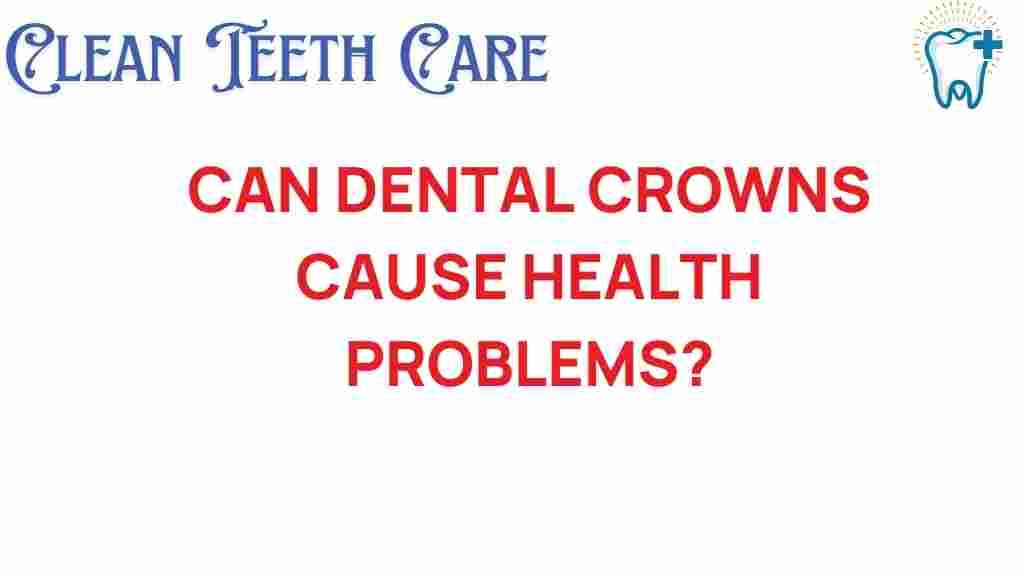Unveiling the Hidden Dangers: Can Dental Crowns Cause Health Problems?
Dental crowns are a common dental procedure used to restore damaged teeth, providing strength and protection. However, while they are generally considered safe and effective, there are hidden dangers and health risks associated with them that patients should be aware of. This article will explore the potential complications of dental crowns, how they impact oral health, and the long-term effects they may have on your overall health. We will also provide troubleshooting tips and insights into ensuring patient safety during dental procedures.
Understanding Dental Crowns and Their Purpose
Before diving into the potential health risks of dental crowns, it’s essential to understand what they are and why they are used. Dental crowns, also known as caps, are prosthetic devices that cover the entire tooth surface, restoring its shape, size, strength, and appearance.
Common Uses of Dental Crowns
- Tooth Restoration: Crowns are often used to repair severely damaged or decayed teeth.
- Post-Root Canal Treatment: After a root canal, a crown may be placed to protect the tooth.
- Cosmetic Improvement: Crowns can enhance the appearance of discolored or misshapen teeth.
- Support for Dental Bridges: Crowns can serve as anchors for bridges, replacing missing teeth.
Potential Health Risks Associated with Dental Crowns
While dental crowns are a standard practice in dental care, they are not without risks. Understanding these potential crown complications is crucial for maintaining your oral health and overall well-being.
1. Allergic Reactions
Some patients may experience allergic reactions to the materials used in dental crowns, particularly metal crowns. Common symptoms include:
- Swelling of the gums
- Itching or rash in the mouth
- Difficulty swallowing or breathing
If you suspect an allergy, consult your dentist immediately for alternatives, such as ceramic or resin crowns.
2. Gum Disease
Improper placement of dental crowns can lead to gaps between the crown and the tooth, trapping food particles and bacteria. This can result in:
- Increased plaque buildup
- Gingivitis or more severe gum disease
- Bad breath
Regular dental check-ups are essential to monitor your gum health after receiving a crown.
3. Tooth Sensitivity
After a crown is placed, some patients may experience tooth sensitivity, particularly to hot or cold temperatures. This sensitivity can arise from:
- The crown being too high, affecting the bite
- Nerve damage during the procedure
- Exposure of the underlying tooth
If sensitivity persists, contact your dentist for an evaluation and possible adjustments.
4. Crown Failure
Crowns can sometimes become loose or fall off, leading to further complications, such as:
- Infection from bacteria entering the exposed tooth
- Increased risk of tooth decay
- Need for additional restorative procedures
Proper care and maintenance are vital to prevent crown failure. Avoid hard foods and maintain good oral hygiene practices.
5. Long-Term Effects
Long-term use of dental crowns can lead to additional issues, including:
- Wear on adjacent teeth due to imbalanced bite
- Changes in jaw alignment over time
- Potential for further tooth decay beneath the crown
Regular dental visits can help monitor these long-term effects and ensure your oral health remains intact.
Step-by-Step Process of Getting a Dental Crown
Understanding the process of getting a dental crown can help alleviate concerns regarding patient safety during dental procedures.
Step 1: Initial Consultation
Your dentist will evaluate your tooth and determine if a crown is necessary. They may take X-rays to assess the condition of the tooth and surrounding bone.
Step 2: Tooth Preparation
The tooth receiving the crown is shaped and reduced in size to accommodate the crown. This may involve removing some of the tooth’s outer structure.
Step 3: Impressions
Your dentist will take impressions of your teeth to create a custom crown that fits perfectly. This can be done using traditional molds or digital scanning technology.
Step 4: Temporary Crown
While your permanent crown is being made, a temporary crown will be placed to protect the prepared tooth.
Step 5: Placement of Permanent Crown
Once your permanent crown is ready, you will return to the dentist for placement. The dentist will ensure the crown fits properly and matches your bite before permanently cementing it in place.
Troubleshooting Tips for Dental Crown Issues
If you encounter problems with your dental crown, follow these troubleshooting tips:
1. Persistent Sensitivity
If you experience ongoing sensitivity, try:
- Using toothpaste designed for sensitive teeth
- Avoiding extreme temperatures
- Contacting your dentist for an evaluation
2. Loose Crown
If your crown feels loose:
- Avoid chewing on that side of your mouth
- Contact your dentist immediately
- Keep the area clean to prevent infection
3. Discomfort or Pain
For discomfort or pain, consider:
- Over-the-counter pain relievers
- Applying a cold compress to the outside of your cheek
- Scheduling a dental appointment for evaluation
Conclusion
While dental crowns are an effective solution for tooth restoration, it is crucial to be aware of the potential health risks and crown complications that may arise. By understanding the process, maintaining good dental care, and staying vigilant about any changes in your oral health, you can minimize risks and ensure the longevity of your dental crowns.
If you have concerns about dental crowns or any dental procedures, consult with your dentist to discuss your options and prioritize your patient safety. For further reading on dental health, visit Dental Health Resources.
Remember, maintaining regular check-ups and open communication with your dental care provider is key to a healthy smile!
This article is in the category Conditions and created by CleanTeethCare Team
